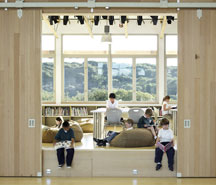Trade Files: EHDD Architecture
TRADE FILES
Name: EHDD Architecture
Location: San Francisco
Website: www.ehdd.com
Phone: 415-285-9193
Markets: Higher Ed and K-12, Aquariums/Zoos/Museums, Civic/Commercial/Cultural, Residential, Science Facilities, Interior Design
Founded: 1946
Employees: 65
SAN FRANCISCO — Founded 64 years ago, EHDD Architecture has developed a broad and diversified portfolio that encompasses a  variety of project types, including sporting facilities, student housing, museums, zoos, art centers, galleries, theaters, academic buildings, K-12 schools, residences, commercial space and offices.
variety of project types, including sporting facilities, student housing, museums, zoos, art centers, galleries, theaters, academic buildings, K-12 schools, residences, commercial space and offices.
 variety of project types, including sporting facilities, student housing, museums, zoos, art centers, galleries, theaters, academic buildings, K-12 schools, residences, commercial space and offices.
variety of project types, including sporting facilities, student housing, museums, zoos, art centers, galleries, theaters, academic buildings, K-12 schools, residences, commercial space and offices.EHDD-designed buildings don’t really have a “defined or pre-selected style” but instead possess their own unique brand while at the same time meeting the needs of the client, says Scott Shell, principal at the firm.
However, if EHDD buildings were to have a defining characteristic, it would likely be sustainable environments.
“We really think of sustainability as a way to enhance and support the client’s vision,” Shell says. “We’re also very focused on buildings that perform very well from an energy standpoint. I think we’re probably the leading firm in the country designing zero-energy buildings.”
EHDD has five zero-energy buildings already in its portfolio. The firm is about to begin construction on two more, Shell says.
EHDD’s commitment to sustainability is especially apparent in the K-12 and higher education market, both of which account for a third to half of the firm’s workload. The firm has four LEED platinum certified academic projects to its name, as well as three LEED gold school facilities and one LEED silver.
“We often find that a lot of the clients that seek us out are the ones who are really interested in sustainable design,” Shell says.
One of the first steps EHDD takes in designing a new building is to put together a preliminary energy model to determine energy usage. For schools, particularly those located in California-like climates, the largest energy user is often lighting.
“We really emphasize daylighting, so a lot of people when they go to our schools remark on how light and bright and open and airy the buildings are,” Shell says. “Daylighting also keeps students more alert and more focused and helps them learn faster. So it has both energy and sustainability benefits, and improves learning rates and saves money.”
EHDD incorporates air ventilation and filtration systems into their designs, creating environments abundant with fresh air and more suited to thinking and learning. In California, the firm has had great success in using radiant heating and cooling along with separate ventilation systems. The use of the two separate systems allows clean air to circulate at various intervals, not just for temperature control.
Building sustainable academic environments is important both to the green construction industry and to teaching the students who learn in these schools, says Shell.
“One of my clients, a board member at a school we’re working on, said to me, ‘Our generation, we’re hopeless.’ But these students today, now they are the future and we want to immerse them in a sustainable school and a sustainable environment and they’ll go out and change the world, because that is what they know,” he says.
“So, creating these sustainable academic environments is huge, because it’s not only where a lot of construction and building is happening in the industry, but it also educates the students who learn in them,” he says.
SELECT SCHOOL PROJECTS
• Christopher Center for Library and Information Resources at Valparaiso University in Valparaiso, Ind.
• UC Merced Science and Engineering Building, LEED Gold certified facility in Merced, Calif.
• City College of San Francisco’s Chinatown/North Beach campus, slated to earn LEED Gold upon completion in 2011.
• Merrill-Crazier Library at Utah State University in Logan, Utah.
• Tenderloin Community School in San Francisco.
HIGHLIGHTS
• Five net-zero energy projects.
• Five LEED Platinum certified structures.
• Four LEED Gold projects, one LEED Silver project.
Three winners of the AIA Committee on the Environment Top Ten Green Projects:
• Chartwell School in Seaside, Calif. (2009); the Global Ecology Research Center in Stanford, Calif. (2007); and the Factor 10 residential house in Chicago (2004).
• 82 percent of the tech staff is LEED accredited.
